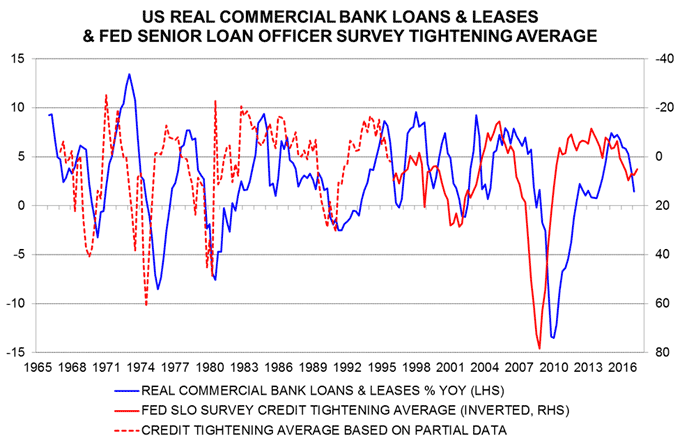Will bank credit easing force faster Fed tightening?
Slow US economic growth over the winter reflected a weakening of money and credit trends from summer 2016. This weakening was probably related to money market fund reforms, which raised banks’ funding costs and tightened the supply of credit. The negative impact of these reforms may be starting to fade, with money trends and credit conditions showing signs of improvement. This could herald economic reacceleration later in 2017.
The Fed’s April survey of senior loan officers, released yesterday, reported a fall in the net percentages of banks tightening credit standards across most loan categories, with the exception of commercial real estate. An average of the net percentages fell to its lowest level since January 2016, having peaked in July – see first chart.

The rise in the average tightening balance into last summer preceded a sharp slowdown in commercial bank loans and leases in late 2016 / early 2017, in line with the historical inverse correlation between the average and subsequent real credit growth – second chart.

Lending weakness was accompanied by a similar slowdown in narrow money and was followed by sub-consensus GDP growth in the fourth quarter of 2016 and first quarter of 2017, as discussed in Friday’s post.
Why did money and credit trends weaken? The view here is that changes to money market fund regulations played an important role by discouraging funds from investing in private sector securities, including bank paper. This pushed up banks’ funding costs, causing them to tighten credit supply. The change in credit conditions probably disrupted some spending plans, in turn causing the demand for narrow money to weaken.
The negative funding cost effect, however, may be fading. The yield spread between three-month financial commercial paper (CP) and Treasury bills rose steadily in advance of the October 2016 implementation date for the money market fund reforms, peaking the month before. It has since retraced two-thirds of the 2015-16 increase. The two-year swap spread followed the CP spread higher but is also now in retreat – third chart.

The modest decline in the average tightening balance in the latest Fed loan officer survey suggests that easier funding conditions are starting to affect banks’ lending behaviour. As noted in Friday’s post, narrow money trends are also showing signs of improvement. The evidence so far is tentative but these developments could be consistent with stronger economic growth in late 2017.
Bank credit tightening in 2016 capped economic strength, resulting in the Fed raising interest rates by less than expected. A reversal of the effect over the remainder of 2017 could force the Fed to step up rate hikes. Such a scenario would be negative for Treasuries and, probably, equities.

Reader Comments